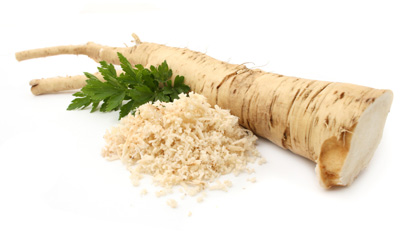The bitter truth about horseradish
Permanent link All Posts
We Jews love our food memories. We have our stand-by recipes that remind us of holidays, family, good times, and bad. And horseradish—maror in Hebrew—is one of those foods.
I can’t even look at the root vegetable without the familiar smell taking me to Passover. I can be standing in my kitchen at work, pulverizing the giant veggie in the middle of a hot summer day, and once I crack open the gnarly looking knob, I am back at the seder.
It is funny, because not many other foods do that for me. I can eat latkes all year round (and do!) and have occasionally snacked on an orphaned box of matzoh I found in a cabinet, months after the holiday. In desperate moments I have greedily gobbled stray gelt and never once thought of Chanukah.
But Horseradish is different. The pungent aroma is so unique and so—Pesadich!
Eating a bitter herb is an important part of the Seder.
There is a commandment in the Torah to eat bitter herbs during the seder together with the Paschal offering. Nowadays since we no longer bring a paschal offering, the commandment to eat maror during the seder is rabbinic in nature.
The reason that we eat the bitter herbs is to commemorate how the oppressive Egyptian slave-masters embittered the lives of the Jewish slaves in Egypt. According to the Talmud, there are different types of food that qualify as maror. The most common custom is to use romaine lettuce, but it is essential that the lettuce be pre-checked for any bugs. Others use grated horseradish and some people have the custom of using both. It is customary to dip the maror in the charoset (culinary bricks-and-mortar mixture) (and then to shake off the charoset) as an antiseptic to its pungent taste.
In addition to the requirement to eat the maror by itself, the maror is also an ingredient in the korech Hillel sandwich in commemoration of the practice at the time of the Temple to eat the matzoh and maror together with the paschal lamb as indicated in the verse “you shall eat it [the Paschal lamb] together.
Smoked salmon schmear
3 ounces Wild Alaskan
Smoked Salmon, chopped finely
1 medium shallot, minced
finely
1 tablespoon prepared
horseradish
2 tablespoons mayonnaise
(homemade or purchased)
2 teaspoons lemon juice
1 tablespoon chopped
fresh dill
Freshly cracked pepper
Garnish: fresh dill,
salmon roe, caviar, crème fraiche (for dairy preparations)
1. Combine all of the ingredients together in a food processor. Pulse several times until the mixture is combined, but still has some texture.
2. Dollop the schmear on latkes fresh out of frying pan and garnish as desired. Store the schmear, covered, in the refrigerator for up to 5 days.
Horseradish crusted standing beef roast
Serves 6-8
Something wonderful happens to horseradish when it is cooked. The pungent root vegetable so tearfully familiar during Pesach becomes sweet and savory once cooked and slathered all over gorgeous beef. The king of all meat cuts is a perfect celebratory gorgeous hunk of meat. It looks intimidating—but is actually really easy and can be done ahead of time and kept warm.
1 4-rib roast
(about 9 pounds), cut from the small end or first cut with the chine bone cut
off (ask your butcher to tie the bones on to the roast)
2 onions,
coarsely chopped
2 red peppers,
coarsely chopped
2 carrots,
coarsely chopped
3 plum tomatoes,
cut in half
4 tablespoons
fresh cracked black pepper
6 tablespoons kosher
salt
1 cup prepared
white horseradish
2 bulbs of
garlic, roasted and the soft garlic squeezed out
1 750 ml bottle dry
red wine (I prefer Cabernet Sauvignon)
2 cups chicken stock, preferably homemade
Preheat oven to 450 degrees
1. Lay the rib roast, bone side down, in a large heavy duty roasting pan. Scatter the vegetables around the roast. These will be the base for wine sauce later.
2. Season the roast with salt and fresh cracked pepper. Mix the horseradish and roasted garlic together.
3. Generously smear the mixture over the rib roast. Place the prepared roast in the pre-heated oven and roast for 20 minutes. Lower the temperature of the oven to 325 and roast for an additional 60 minutes.
4. Insert a meat thermometer into the thickest part of the roast and when the temperature registers 115 (for rare-medium rare), remove the roast. Loosely tent the meat with foil and allow to rest for 20 minutes. This will allow the final temperature to be around 125-130. The internal temperature will continue to rise in a process called “carry-over” cooking.
5. Remove the meat and place the roasting pan over a burner at medium heat. Add the wine and gently scrape up any brown bits with a wooden spoon. Continue cooking until the wine has reduced by half. Strain out the vegetables and discard. Add the stock and continue cooking until the sauce has reduced and coats the back of a spoon. Adjust seasoning with salt and fresh cracked pepper.
6. Remove the bones and slice the meat. Serve on a platter with wine sauce and sautéed mushrooms if desired.
7. To hold the meat for Shabbat: Once the meat has reached the desired temperature, turn off the oven and remove the meat as in step 4. After the meat has rested and any carry over cooking is finished, return the meat back to the warm oven. Allow the door to stand slightly open and the meat will stay warm for another 30 minutes or more.



.jpg)



